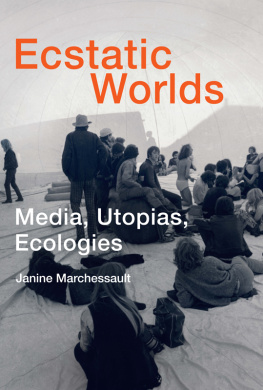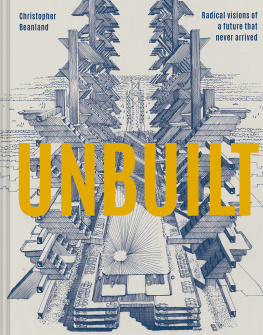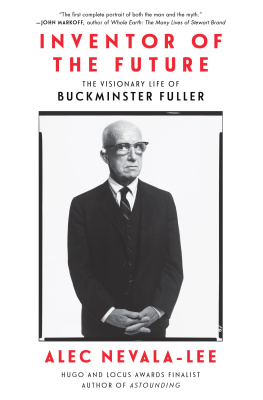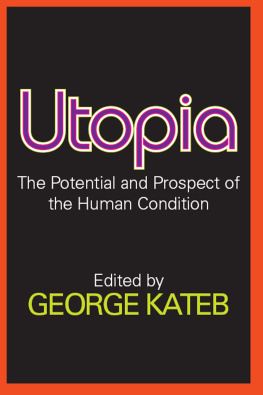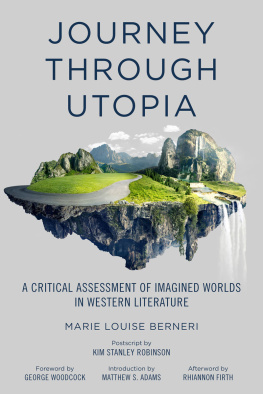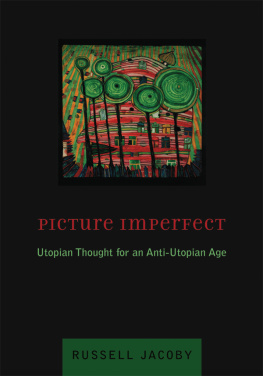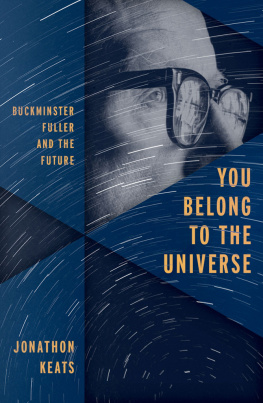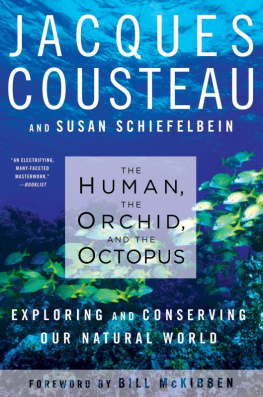Marchessault - Ecstatic Worlds: Media, Utopias, Ecologies
Here you can read online Marchessault - Ecstatic Worlds: Media, Utopias, Ecologies full text of the book (entire story) in english for free. Download pdf and epub, get meaning, cover and reviews about this ebook. year: 2017, publisher: MIT Press, genre: Romance novel. Description of the work, (preface) as well as reviews are available. Best literature library LitArk.com created for fans of good reading and offers a wide selection of genres:
Romance novel
Science fiction
Adventure
Detective
Science
History
Home and family
Prose
Art
Politics
Computer
Non-fiction
Religion
Business
Children
Humor
Choose a favorite category and find really read worthwhile books. Enjoy immersion in the world of imagination, feel the emotions of the characters or learn something new for yourself, make an fascinating discovery.
- Book:Ecstatic Worlds: Media, Utopias, Ecologies
- Author:
- Publisher:MIT Press
- Genre:
- Year:2017
- Rating:3 / 5
- Favourites:Add to favourites
- Your mark:
- 60
- 1
- 2
- 3
- 4
- 5
Ecstatic Worlds: Media, Utopias, Ecologies: summary, description and annotation
We offer to read an annotation, description, summary or preface (depends on what the author of the book "Ecstatic Worlds: Media, Utopias, Ecologies" wrote himself). If you haven't found the necessary information about the book — write in the comments, we will try to find it.
Ecstatic Worlds: Media, Utopias, Ecologies — read online for free the complete book (whole text) full work
Below is the text of the book, divided by pages. System saving the place of the last page read, allows you to conveniently read the book "Ecstatic Worlds: Media, Utopias, Ecologies" online for free, without having to search again every time where you left off. Put a bookmark, and you can go to the page where you finished reading at any time.
Font size:
Interval:
Bookmark:

Leonardo
Roger F. Malina, Executive Editor
Sean Cubitt, Editor-in-Chief
Green Light: Toward an Art of Evolution, George Gessert, 2010
Enfoldment and Infinity: An Islamic Genealogy of New Media Art, Laura U. Marks, 2010
Synthetics: Aspects of Art and Technology in Australia, 19561975, Stephen Jones, 2011
Hybrid Cultures: Japanese Media Arts in Dialogue with the West, Yvonne Spielmann, 2012
Walking and Mapping: Artists as Cartographers, Karen ORourke, 2013
The Fourth Dimension and Non-Euclidean Geometry in Modern Art, revised edition, Linda Dalrymple Henderson, 2013
Illusions in Motion: Media Archaeology of the Moving Panorama and Related Spectacles, Erkki Huhtamo, 2013
Relive: Media Art Histories, edited by Sean Cubitt and Paul Thomas, 2013
Re-collection: Art, New Media, and Social Memory, Richard Rinehart and Jon Ippolito, 2014
Biopolitical Screens: Image, Power, and the Neoliberal Brain, Pasi Vliaho, 2014
The Practice of Light: A Genealogy of Visual Technologies from Prints to Pixels, Sean Cubitt, 2014
The Tone of Our Times: Sound, Sense, Economy, and Ecology, Frances Dyson, 2014
The Experience Machine: Stan VanDerBeeks Movie-Drome and Expanded Cinema, Gloria Sutton, 2014
Hanan al-Cinema: Affections for the Moving Image, Laura U. Marks, 2015
Writing and Unwriting (Media) Art History: Erkki Kurenniemi in 2048, edited by Joasia Krysa and Jussi Parikka, 2015
Control: Digitality as Cultural Logic, Seb Franklin, 2015
New Tendencies: Art at the Threshold of the Information Revolution (19611978), Armin Medosch, 2016
Screen Ecologies: Art, Media, and the Environment in the Asia-Pacific Region, Larissa Hjorth, Sarah Pink, Kristen Sharp, and Linda Williams, 2016
Pirate Philosophy: For a Digital Posthumanities, Gary Hall, 2016
Social Media Archeology and Poetics, edited by Judy Malloy, 2016
Practicable: From Participation to Interaction in Contemporary Art, edited by Samuel Bianchini and Erik Verhagen, 2016
Machine Art in the Twentieth Century, Andreas Broeckmann, 2016
Here/There: Telepresence, Touch, and Art at the Interface, Kris Paulsen, 2017
Voicetracks: Attuning to Voice in Media and the Arts, Norie Neumark, 2017
Ecstatic Worlds: Media, Utopias, Ecologies, Janine Marchessault, 2017
See for a complete list of titles in this series.
Janine Marchessault
The MIT Press
Cambridge, Massachusetts
London, England
2017 Massachusetts Institute of Technology
All rights reserved. No part of this book may be reproduced in any form by any electronic or mechanical means (including photocopying, recording, or information storage and retrieval) without permission in writing from the publisher.
This book was set in ITC Stone Sans Std and ITC Stone Serif Std by Toppan Best-set Premedia Limited. Printed and bound in the United States of America.
Library of Congress Cataloging-in-Publication Data
Names: Marchessault, Janine author.
Title: Ecstatic worlds : media, utopias, ecologies / Janine Marchessault.
Description: Cambridge, MA : The MIT Press, 2017. | Series: Leonardo book series | Includes bibliographical references and index.
Identifiers: LCCN 2016053947 | ISBN 9780262036467 (hardcover : alk. paper)
eISBN 9780262341134
Subjects: LCSH: Mass media--Technological innovations. | Mass media--Social aspects.
Classification: LCC P96.T42 M355 2017 | DDC 302.23--dc23 LC record available at https://lccn.loc.gov/2016053947
ePub Version 1.0
Leonardo, the International Society for the Arts, Sciences, and Technology, and the affiliated French organization Association Leonardo, have some very simple goals:
- To advocate, document, and make known the work of artists, researchers, and scholars developing the new ways in which the contemporary arts interact with science, technology, and society.
- To create a forum and meeting place where artists, scientists, and engineers can meet, exchange ideas, and, when appropriate, collaborate.
- To contribute, through the interaction of the arts and sciences, to the creation of the new culture that will be needed to transition to a sustainable planetary society.
When the journal Leonardo was started some fifty years ago, these creative disciplines usually existed in segregated institutional and social networks, a situation dramatized at that time by the Two Cultures debates initiated by C. P. Snow. Today we live in a different time of cross-disciplinary ferment, collaboration, and intellectual confrontation enabled by new hybrid organizations, new funding sponsors, and the shared tools of computers and the Internet. Sometimes captured in the STEM to STEAM movement, new forms of collaboration seem to integrate the arts, humanities, and design with science and engineering practices. Above all, new generations of artist-researchers and researcher-artists are now at work individually and collaboratively bridging the art, science, and technology disciplines. For some of the hard problems in our society, we have no choice but to find new ways to couple the arts and sciences. Perhaps in our lifetime we will see the emergence of new Leonardos, hybrid creative individuals or teams that will not only develop a meaningful art for our times but also drive new agendas in science and stimulate technological innovation that addresses todays human needs.
For more information on the activities of the Leonardo organizations and networks, please visit our websites at http://www.leonardo.info/ and http://www.olats.org/. Leonardo Books and journals are also available on our ARTECA art/science/technology aggregator: http://arteca.mit.edu/.
Roger F. Malina
Executive Editor, Leonardo Publications
ISAST Governing Board of Directors: Nina Czegledy, Greg Harper, Marc Hebert (Chair), Gordon Knox, Roger Malina, Tami Spector, J. D. Talasek, Darlene Tong, Joel Slayton, John Weber
Leonardo Book Series Editor-in-Chief: Sean Cubitt
Advisory Board: Annick Bureaud, Steve Dietz, Machiko Kusahara, Jos-Carlos Mariategui, Laura U. Marks, Anna Munster, Monica Narula, Michael Punt, Sundar Sarukkai, Joel Slayton, Mitchell Whitelaw, Zhang Ga
Ecstatic Worlds grows out of my many years of working on public art projects with the Public Access Collective in Toronto, and I am indebted to the different members of the collective and to the many artists with whom I have collaborated. I am grateful to my long-time interlocutors Susan Lord, Scott Mackenzie, and Michael Zryd who generously read and commented on more chapter drafts than they probably care to remember. Kathy Daymond and Tim Pearson also read and commented on drafts of chapters. Michael Prokopow and Tyler Survant were supportive at critical points. My collaborators Michael Darroch and Monika Gagnon helped to nurture different ideas that are woven into this book. I am thankful to Christine Davis for wonderful exchanges about art, curation, and public space over the course of writing this book.
I have had the honor of interviewing legendary experimental and multiscreen filmmakers Michael Snow, Graeme Ferguson, Christopher Chapman, Roman Kroitor, Colin Low, Morley Markson, and Toni Myers, from whom I learned so much about the materiality of cinema and spectatorship. My fortunate encounters with luminaries such as Gerry OGrady, Perttu Rastas, Anthony Vidler, Chantal Mouffe, Nikos Papastergiadis, and Fulya Erdemci at opportune moments in the books development helped to shape several of the chapters. I enjoyed interviewing Martin Heath on several occasions, and I am deeply appreciative for having had access to his rich CineCycle archive. He introduced me to Graham Stevenss wonderful pneumatic endeavors. I have also benefited from conversations with Chip Lord and Curtis Schreier of Ant Farm, who generously discussed some of their historical projects and steered me toward some new ones. I am grateful to numerous artists for providing me with information and in some cases photographs of their work: Graham Stevens, Mika Taanila, Amy Balkin, Tania Mouraud, WORKac (Amale Andraos and Dan Wood), John Porter, and Andrew Paterson. The painstaking work of archivists and curators is essential for researchers, and I am indebted to the following people and archives: Carol Stewart, Patrick Geddes Papers, Archives and Special Collections, University of Strathclyde; Tony Dykes, BFI National Archive; the Jaqueline Tyrwhitt Collection, Archives of the Royal Institute of British Architects; Liz Kurtulik Mercuri, MoMA: The Edward Steichen Archive; the fonds Louis Malle, Cinmathque franaise; Stephanie Cannizzo and Tracy Jones at the Berkeley Art Museum & Pacific Archive; Paul Gordon at Library and Archives Canada.
Next pageFont size:
Interval:
Bookmark:
Similar books «Ecstatic Worlds: Media, Utopias, Ecologies»
Look at similar books to Ecstatic Worlds: Media, Utopias, Ecologies. We have selected literature similar in name and meaning in the hope of providing readers with more options to find new, interesting, not yet read works.
Discussion, reviews of the book Ecstatic Worlds: Media, Utopias, Ecologies and just readers' own opinions. Leave your comments, write what you think about the work, its meaning or the main characters. Specify what exactly you liked and what you didn't like, and why you think so.

